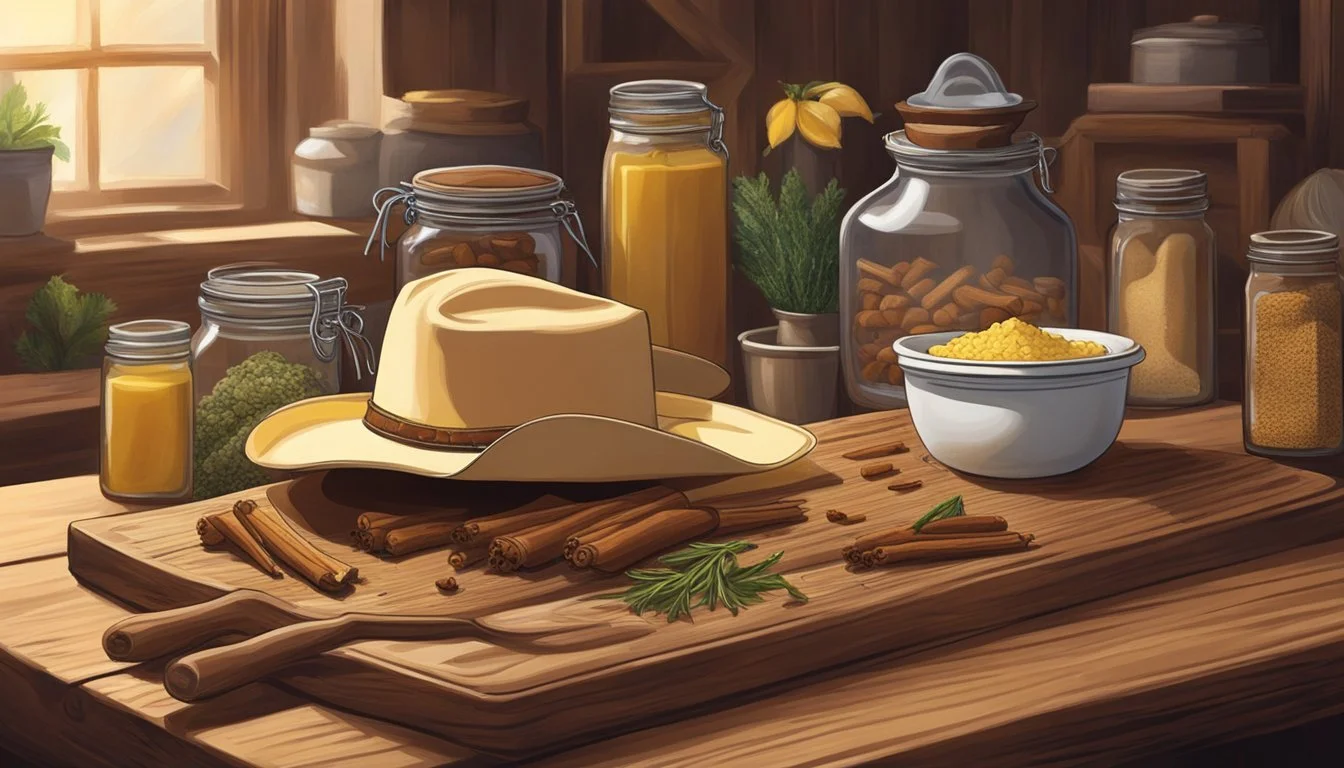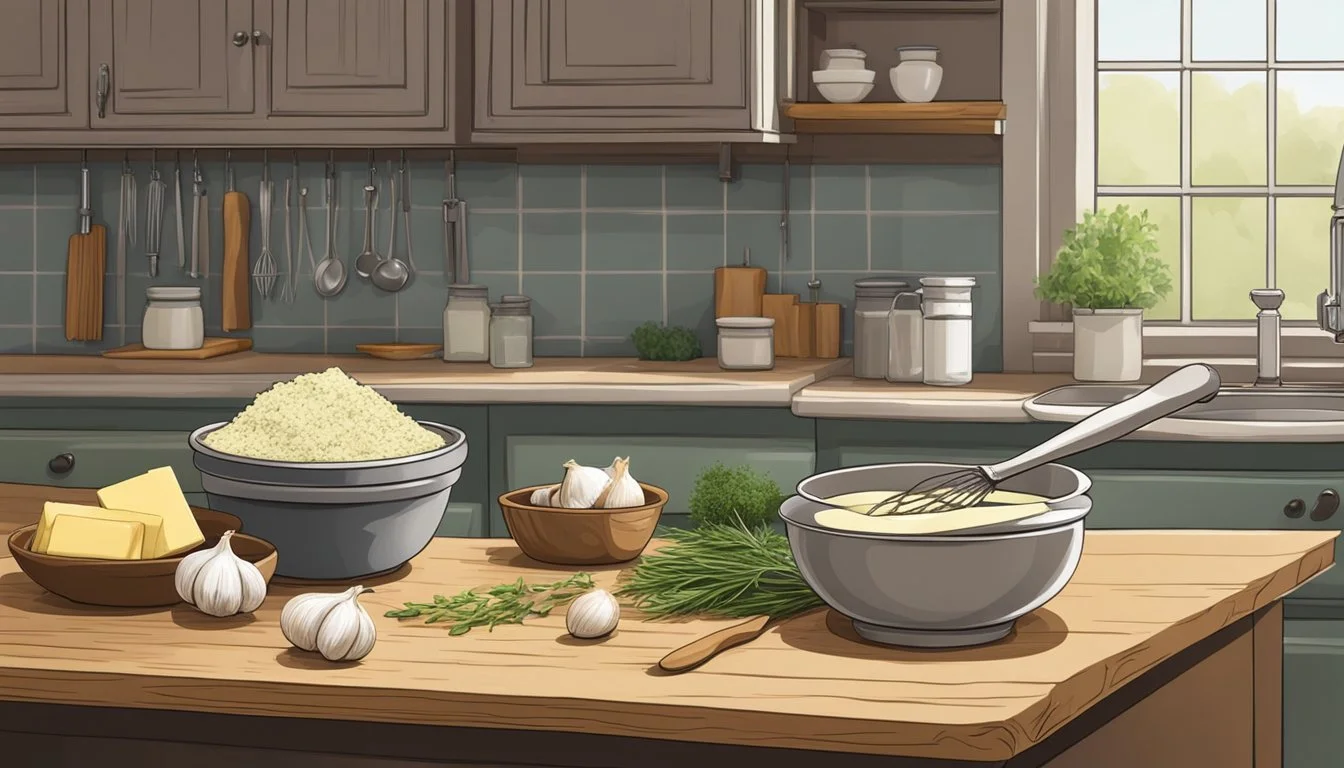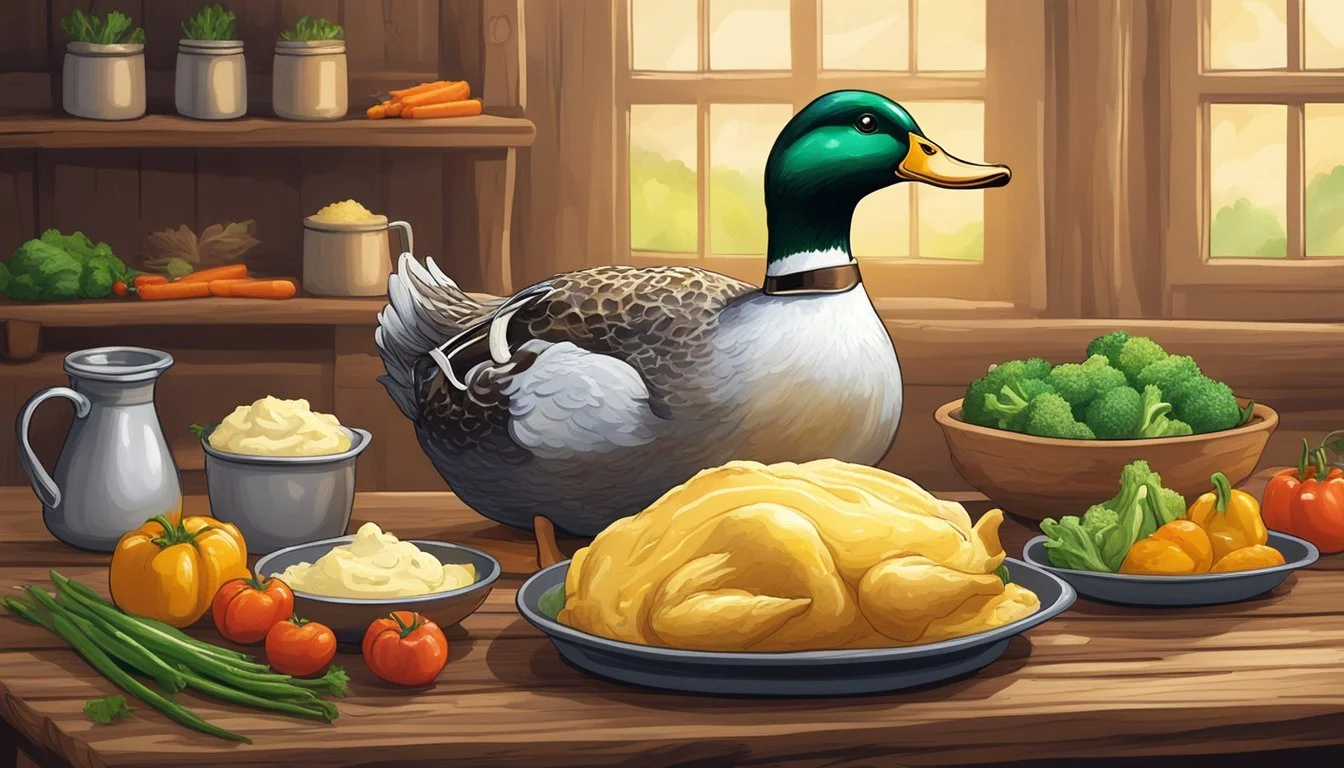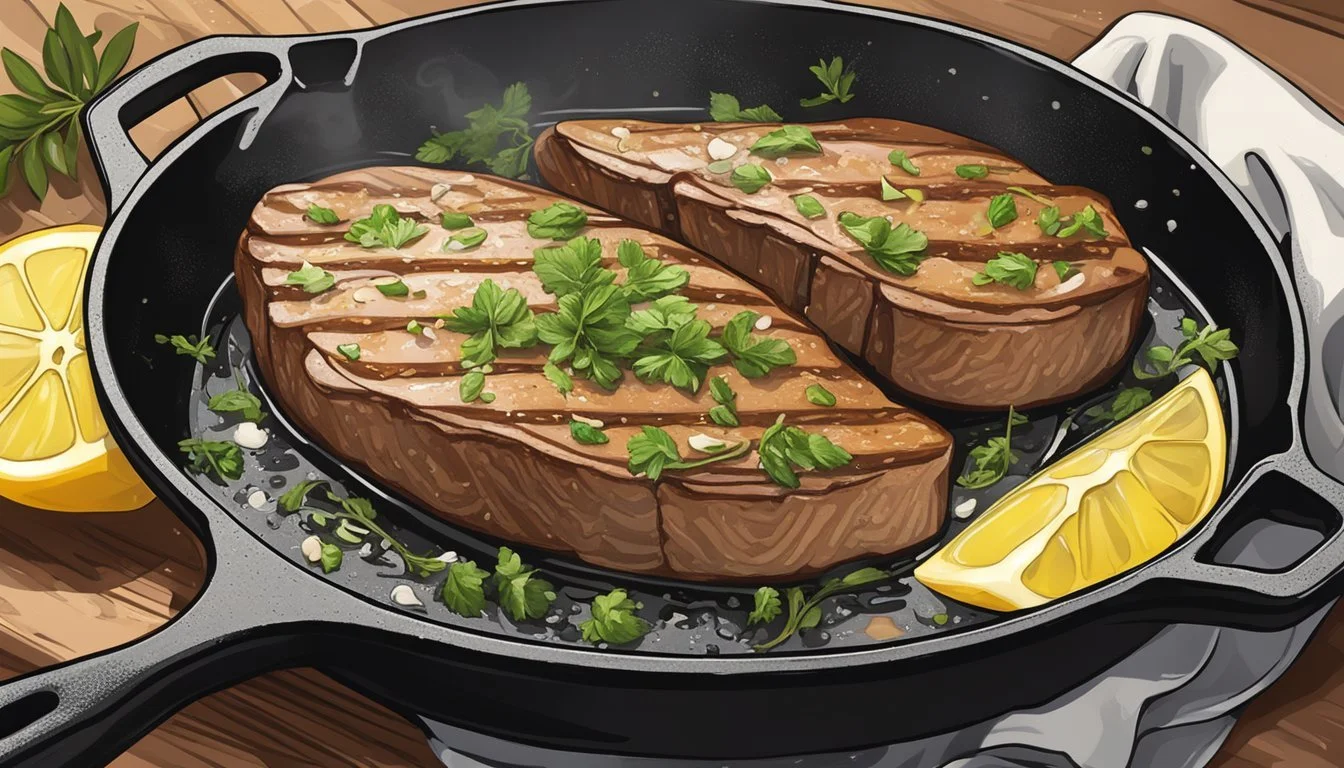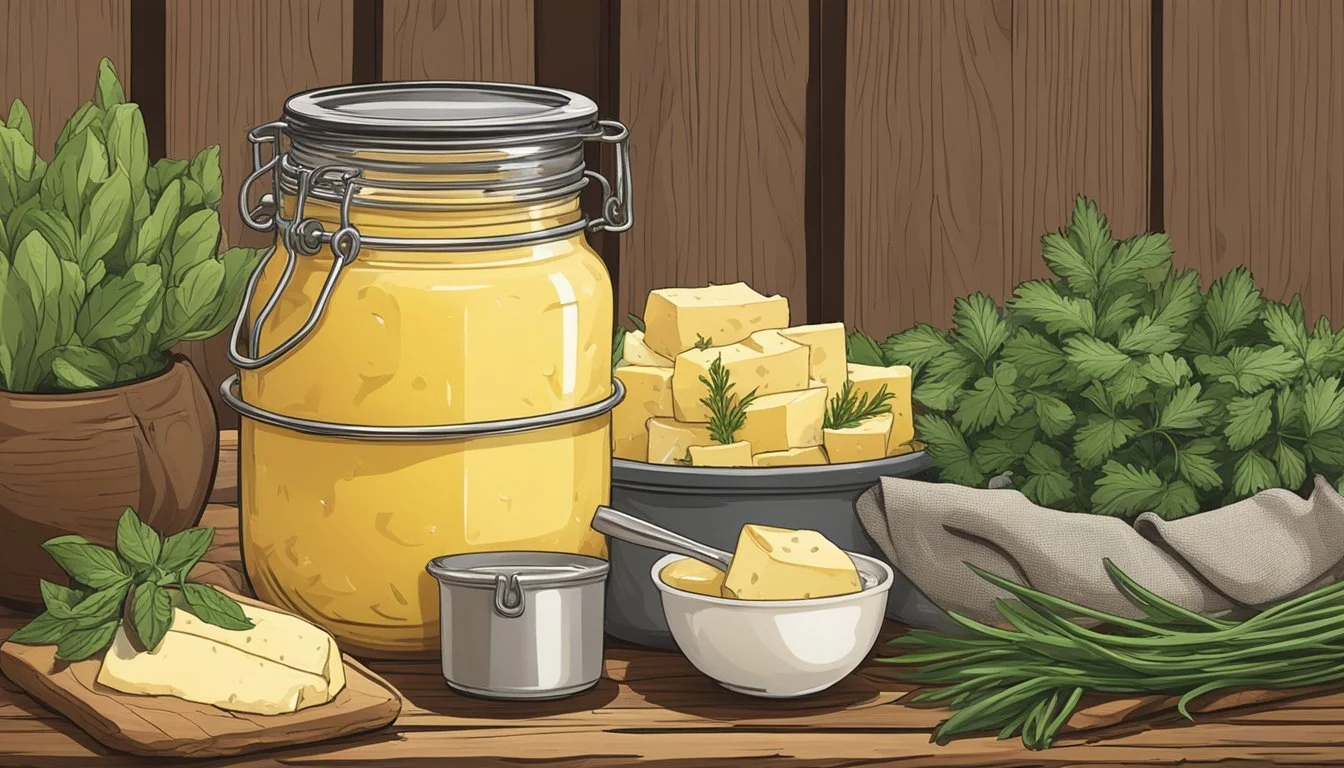Cowboy Butter Duck
Elevate Your Dinner Game with This Decadent Dish
Cowboy Butter Duck (What wine goes well with duck?) merges the richness of roasted duck with the zest and spice of cowboy butter, creating an indulgent dining experience that excites the palate with its layers of flavor. Cowboy butter, a compound butter brimming with herbs, spices, garlic, and a kick of citrus, transforms the tender canvas of duck into a gourmet masterpiece. As a condiment, it infuses the meat with a blend of flavor that is as robust as it is memorable, ensuring that every bite provides a burst of flavor.
The preparation of the dish maintains a balance between simplicity and sophistication. It elevates a traditional roast duck by enveloping it in the boldness of cowboy butter, which is simple to prepare but complex in taste. The butter's components, like garlic and herbs, complement the natural savory notes of the duck, while lemon and spices add a refreshing contrast that cuts through the richness. This elevated take on duck promises to impress at any table, offering a centerpiece that is not only visually appealing but also a symphony of tastes.
What sets this meal apart is the versatility of cowboy butter as a flavor enhancer. It can be prepared ahead of time and added to the dish as it cooks or presented as a melting garnish upon serving, allowing for culinary creativity. Through its dynamic blend of flavors, cowboy butter duck becomes more than just a meal; it presents itself as a journey through various taste sensations, making it a standout dish for both family dinners and gourmet gatherings.
Exploring the Origins of Cowboy Butter
Cowboy butter is a seasoned compound butter that has gained popularity for its rich flavors, rooted in a mixture of spices, herbs, and butter. Its exact birthplace is uncertain, but it falls into a culinary tradition of enhancing butter to elevate dishes.
The history of enhancing butter goes back centuries, predominantly noted in French cuisine, which has a long-standing practice of creating compound butters. These preparations often incorporate a variety of herbs and spices, similar to cowboy butter. Although cowboy butter is a contemporary term, the concept of flavored butter is not new.
Ree Drummond, the food enthusiast and TV personality known as The Pioneer Woman, is frequently credited with popularizing the name "cowboy butter." Drummond introduced this butter on her cooking show and blog, where she infused it with a signature Western twist, making it a staple for grilled meats (What wine goes well with grilled meats?) and bread.
The components of cowboy butter are primarily butter, garlic, and a selection of herbs and spices that can include, but not limited to:
Garlic: for a robust flavor.
Parsley and chives: for freshness and vibrancy.
Chili flakes: to add a dash of heat.
Lemon juice and zest: for a tangy kick.
Cowboy butter can be seen as the American West's take on the French’s beurre maître d'hôtel, a classic compound butter but infused with a bolder flavor profile suited to hearty American cooking traditions.
Essential Ingredients and Substitutions
Creating a delectable Cowboy Butter Duck involves understanding the core ingredients that create its rich flavor profile and knowing how to adapt it to meet different dietary needs without sacrificing taste.
Core Components of Cowboy Butter
Cowboy Butter is a compound butter that elevates dishes with its complex combination of flavors. Key ingredients include:
Butter: Acts as a base, with salted butter enhancing the taste, though unsalted butter is an option if managing sodium intake.
Herbs: Fresh herbs like parsley and chives infuse freshness.
Garlic: Essential for the characteristic piquancy.
Lemon Juice and Zest: Brings a bright, citrusy note.
Dijon Mustard: Adds a tangy depth.
Spices: A blend that typically includes paprika, black pepper, and cayenne to add warmth and spice.
Customizing Your Cowboy Butter Blend
Flavor: One can experiment with the balance of herbs and spices to tailor the flavor profile.
For instance, increasing the lemon zest can enhance the zesty citrus flavor, while varying the types of pepper can adjust the heat level.
Textures: A smoother texture can be achieved by using powdered versions of garlic or onion, whereas using them fresh or minced introduces more texture.
Substitution Suggestions for Dietary Needs
Lactose intolerance: Substitute traditional butter with a plant-based alternative.
Salt content: Use unsalted butter and control the amount of added salt. Sodium-free salt substitutes can also be used.
Herbs and Spices: Dried herbs can replace fresh if necessary, though they should be used in smaller quantities due to a more concentrated flavor. Organic or non-irradiated herbs and spices may be preferred for health reasons.
Mustards: If avoiding grains or additives found in some Dijon mustards, one can opt for stone-ground or homemade mustard.
By carefully selecting and substitifying ingredients, one can craft Cowboy Butter that honors dietary preferences without compromising the rich flavor that makes it an excellent accompaniment to duck.
The Step-by-Step Cowboy Butter Recipe
Creating the perfect Cowboy Butter involves preparing an herb mixture, forming the butter into a log for convenient use, and understanding how to store it for longevity—ensuring it's ready to enhance the flavor of meats, vegetables, or bread when needed.
Preparing the Herb Mixture
To begin, finely mince 2 cloves of garlic, 2 tablespoons of fresh chives, and 2 tablespoons of fresh parsley. Grate the zest of one lemon to gather one tablespoon of lemon zest. In a small bowl, combine these with 1 teaspoon of fresh thyme leaves. The aromatic herbs, pungent garlic, and citrusy lemon zest will form the flavor base of the compound butter.
Mixing and Shaping the Butter Log
Melt 1 stick (1/2 cup) of unsalted butter over medium heat in a saucepan.
Stir the dipped herbs and the lemon zest into the melted butter.
Whisk in 1 tablespoon of Dijon mustard, 1 teaspoon of smoked paprika, a pinch of salt, black pepper, chili powder, and crushed red pepper flakes to taste.
Remove from heat and allow the mixture to cool slightly.
Lay out a piece of plastic wrap or wax paper on the counter.
Spoon the butter mixture onto the wrap, and fold the paper over it.
Shape the butter into a tight log shape, and twist the ends to seal it like a candy wrapper.
Storing and Preserving Cowboy Butter
To store the cowboy butter, place the wrapped log into the refrigerator where it will solidify and can be kept for up to two weeks. For longer preservation, freeze the cowboy butter log inside a zipper storage bag, where it can be stored for several months. When needed, simply slice off rounds from the refrigerated or frozen log as needed for each use.
Serving Suggestions and Pairings
Cowboy butter is a versatile compound butter that pairs exceptionally well with a variety of foods. Spread it on warm bread, dollop it onto grilled meats like steak, or use it to season vegetables. It can be melted and used as a dip for shrimp or lobster, or simply allowed to melt over grilled steak or veggies for a flavorful, delicious finish.
Nutritional Information and Dietary Considerations
Cowboy Butter Duck offers a balance of savory flavors and fats. Its nutrient profile is valuable for those considering its place in a dietary plan. The section below details the nutritional aspects of the dish, focusing on specific components such as calories, fats, and sodium.
Caloric and Fat Content
Duck meat is known for its high fat content, which contributes to the calorie count of the meal. Including the skin in the recipe increases both caloric and fat levels. A typical serving of duck can have:
Calories: Around 200-250 per 100 grams.
Total Fat: 11-15 grams, which may vary based on cooking method and portion size.
Of the fats present in duck:
Saturated fat: Can be significant but varies with preparation.
Unsaturated Fat: Present in beneficial forms such as omega-3 fatty acids.
Sodium and Sugar Levels
While duck innately contains a moderate amount of sodium, Cowboy Butter Duck preparation could increase this due to added ingredients such as salted butter and seasonings. Typically, duck meat contains:
Sodium: Roughly 60-100 milligrams per 100 grams.
Sugar: Duck is naturally sugar-free, but sauces or glazes may add sugar content.
For those monitoring sodium intake, it's wise to adjust the recipe by using unsalted butter and reducing additional salt.
Adapting the Recipe for Healthier Variants
To create a more health-conscious version of Cowboy Butter Duck, consider the following adjustments:
Substitute unsalted butter to reduce sodium content.
Trim excess skin off the duck to lower saturated fat.
Use fresh herbs and spices to enhance the flavor profile without added fats or sugars.
Through mindful modifications, it's possible to enjoy Cowboy Butter Duck as part of a balanced, nutritious diet.
Creative Ways to Use Cowboy Butter in Cooking
Cowboy butter offers a rich blend of spices and herbs brought together in a luscious buttery base, enhancing the flavors of various dishes. This versatile condiment can transform simple ingredients into gourmet meals with its robust taste.
Enhancing Meat Dishes
Cowboy butter serves as a flavorful ally in the preparation of meat dishes. Whether they opt for steak, pork chops, or chicken breasts, cooks can either baste meats with cowboy butter during the last few minutes of grilling for a succulent finish or allow proteins to rest in a spoonful of this compound butter for an extra layer of flavor.
Steak: Brush on during the last 2 minutes of grilling.
Pork: Rest cooked chops on a dollop of cowboy butter.
Chicken: Baste while roasting for a juicy, flavorful skin.
Vegetarian and Vegan Alternatives
One doesn't need to forgo this deep-flavored butter when following a vegetarian or vegan lifestyle. By using plant-based butter alternatives and pairing with roasted vegetables (What wine goes well with roasted vegetables?) or tofu, individuals can still enjoy the complex flavors of cowboy butter.
Roasted Vegetables: Toss in cowboy butter before roasting.
Vegan Spread: Mix with plant-based butter and serve on garlic bread.
Beyond the Grill: Baking and Roasting
Cowboy butter is not limited to grilling; it plays well in baking and roasting too. It can be brushed on seafood before baking for a zesty twist or stirred into sauces to enrich the dish's overall taste.
Fish: Spread over filets before baking in the oven.
Sauces: Stir into pasta sauces for added depth.
Dipping Sauce: Use as a stand-alone dip for crustaceans like shrimp and lobster.
Tips for Perfecting Your Cowboy Butter Technique
To ensure a flavor-packed Cowboy Butter, one must start with softened butter at room temperature. This allows for easier integration of spices and ensures that the butter is smooth after mixing.
In preparation, they should choose a saucepan appropriate for the amount of butter being used. A smaller saucepan provides better heat control for a smaller quantity, preventing any one area from overheating or burning.
Ingredients Integration:
Begin with melting the butter in the saucepan over medium heat.
Carefully monitor the butter to avoid burning, stirring continuously for a smooth texture.
Once melted, they should lower the heat before adding the seasoning to infuse flavors without scorching the spices.
Temperature Management:
Maintaining a low heat is critical after spices are added.
Gradual warming allows the flavors to meld without altering the base texture of the butter.
Mixing Techniques:
A sturdy whisk helps to incorporate all seasoning evenly.
Continual whisking until all elements are well combined produces a smooth and cohesive sauce.
Consistency Tips:
A well-prepared Cowboy Butter should be silken and glossy.
If the butter begins to separate or look grainy, they have overheated it and should remove it from the heat immediately to cool while whisking vigorously.
By adhering to these tips, they can avoid common pitfalls and perfect their Cowboy Butter technique, creating a luxurious complement for a gourmet duck dish.
Saving and Reusing Leftover Cowboy Butter
When it comes to utilizing leftover Cowboy Butter, storing it properly is crucial to maintain its flavor and quality. If there's any Cowboy Butter remaining after preparing and serving your dish, it should be transferred into an airtight container or securely wrapped in plastic wrap. Refrigeration is recommended to preserve its freshness and extend its shelf life. Typically, Cowboy Butter can be refrigerated for up to two weeks.
Freezing is another viable option for longer storage. To freeze, one may portion the butter by spoonfuls on a baking sheet or roll it into a log using parchment paper and then encase in plastic wrap. Once solidified, these portions can be easily transferred to a freezer-safe bag or container, allowing for convenient future use.
When ready to reuse, the Cowboy Butter can simply be thawed in the refrigerator. It is an incredibly versatile condiment and can be used as a flavorful topping for a variety of dishes. Here are some ideas:
Steaks and Poultry: Enhance the flavor of meats by adding a dollop of Cowboy Butter towards the end of cooking or once served.
Vegetables: Toss roasted or grilled vegetables with a bit of Cowboy Butter for an instant upgrade.
Baked Potatoes: Substitute plain butter with Cowboy Butter for a dressed-up side dish.
Breads: Spread Cowboy Butter on freshly baked bread or dinner rolls for a special touch.
By properly saving and repurposing leftovers, food waste is significantly reduced and every meal can be infused with the rich and tangy flavors of Cowboy Butter even days after the initial preparation.
Pairing Cowboy Butter with International Cuisines
Cowboy Butter, a flavorful condiment, enhances various international dishes with its robust blend of garlic, herbs, and spices. When considering Cowboy Butter as an international staple, the adaptation of herbs like thyme, rosemary, and cilantro can be pivotal. Each herb contributes a unique profile that complements different international flavors.
European Cuisine: In European dishes, the herbaceous notes of thyme and rosemary marry well with Cowboy Butter. An Italian bruschetta or a French roast chicken could be elevated with this butter's savory undertones.
Country Dish Herb Consideration Italy Bruschetta Rosemary enhances aroma France Roast Chicken Thyme accentuates depth
Mexican Cuisine: Cowboy Butter fused with cilantro can bring a zesty twist to classics like tacos or fajitas. The cilantro's bright flavor harmonizes with the chili and paprika in the butter.
Tacos: A cilantro-infused Cowboy Butter can add complexity.
Fajitas: The herb aligns with the smoky, grilled nature of the dish.
Asian Cuisine: While not traditional, a version with reduced chili can be subtle enough to complement Asian dishes without overpowering them.
Incorporating thyme into Cowboy Butter could be an exciting addition to an aromatic Thai curry, providing a background note that doesn't compete with the lemongrass or galangal.
Thai Curry: A hint of thyme brings an earthy undertone.
One should be mindful of the richness and compete with indigenous flavors respectfully when integrating Cowboy Butter into international cuisine. Through thoughtful pairings, chefs and home cooks alike can introduce a Western twist to global plates with a touch of creativity and flair.
Unpacking the Flavor Profile of Cowboy Butter
Cowboy Butter is an indulgent condiment that boasts a multidimensional flavor profile, aligning with a gourmet culinary experience. It combines a savory base with layers of citrus and a spicy kick that enhances the rich character of dishes such as Cowboy Butter Duck.
Savory Foundation:
The central component of Cowboy Butter is unsalted butter, which provides a creamy and rich foundation. The savory aspect is further enriched by the addition of minced garlic, contributing a fragrant depth that's fundamental in hearty cooking.
Citrus Zest:
Bright notes of citrus cut through the richness with the inclusion of lemon juice and zest. The citrus elements introduce a refreshing contrast, offering a subtle tang that invigorates the palate.
Spicy Elements:
For those who favor heat, Cowboy Butter introduces a spicy dimension with red pepper flakes and cayenne pepper. These ingredients deliver a pleasant warmth that complements the butter's richness without overwhelming the taste buds.
Herbaceous Touch:
Fresh herbs like parsley, dill, and chives are often woven into Cowboy Butter, contributing a layer of complexity. Their green and aromatic qualities harmonize with the savory butter, citrus lift, and spicy notes to achieve a balanced and full-bodied flavor.
Ingredient Flavor Contribution Unsalted butter Rich and creamy base Garlic Savory and aromatic Lemon zest Refreshing citrus Red pepper flakes Subtle spiciness Fresh herbs Herbaceous and green
In summary, Cowboy Butter's flavor profile is a well-orchestrated symphony of rich and savory, zestfully citrus, and warmly spicy notes, concluded with an herbaceous freshness that has become synonymous with cultivated taste.
Q&A: Common Questions About Cowboy Butter
What is Cowboy Butter?
Cowboy Butter is a compound butter that incorporates a mixture of flavors such as garlic, citrus, herbs, and spices. It's often used to enhance the taste of grilled meats and vegetables.
How do you make Cowboy Butter?
To craft Cowboy Butter, one typically needs:
Softened butter
Garlic, minced
Fresh herbs like parsley, chives, and thyme
Lemon juice and zest
Spices like red pepper, paprika, and black pepper
One would combine these ingredients, then wrap the mixture in parchment and chill it to solidify.
What are some tips for using Cowboy Butter with duck?
When using Cowboy Butter with duck, it's best to:
Allow the butter to soften so it can be easily mixed with the additional flavoring agents.
Spread the butter under the duck's skin before roasting to infuse flavor into the meat.
Baste the duck with melted Cowboy Butter during cooking for a flavorful crust.
Is there any confusion about the moisture content in Cowboy Butter?
Some may confuse Cowboy Butter's moisture content with that of its primary ingredient, butter, which typically contains 15-20% water. However, the added ingredients do not significantly alter its moisture content.
Can Cowboy Butter be adjusted for individual tastes?
Yes, Cowboy Butter is versatile. Ingredients can be adjusted to taste, such as:
Increasing or decreasing the amount of lemon juice for acidity.
Adjusting the garlic and spices to flavor preference.
Any suggestions for presenting Cowboy Butter with duck?
For a gourmet presentation:
Slice the chilled Cowboy Butter and place atop the roasted duck.
Alternatively, serve the Cowboy Butter in a small dish alongside the duck for individual use.


